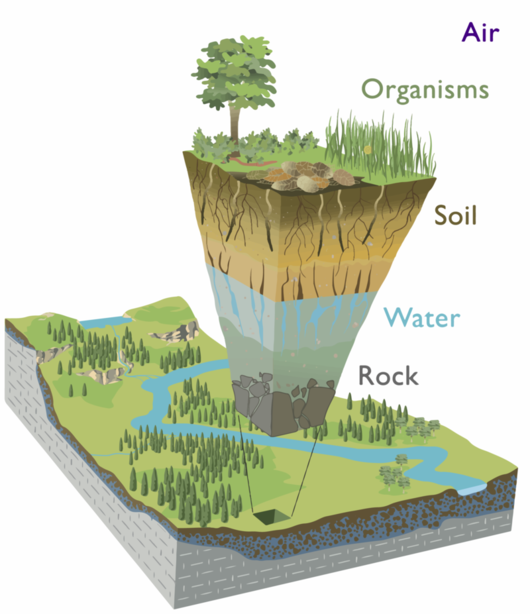Critical zone

The Critical Zone is a theoretical concept that connects the atmosphere, biosphere, pedosphere, water, and nutrient availability for life systems. An overarching idea that, if true, connects all systems within this zone and regulates all of terrestrial life. The concept was first published by the National Research Council in 2000, and their initial depiction of the Critical Zone describes it as the "heterogeneous, near-surface environment in which complex interactions involving rock, soil, water, air, and living organisms regulate the natural habitat and determine the availability of life-sustaining resources". [1]
Properties
The Critical Zone is a unique section of Earth to study, and a large number of variables make quantifying and relating data difficult. Response time to outside forcings on the critical zone varies wildly, depending on what the source was. For example, a flood would be a relatively quick response, while the response to heavy metal pollution in soil may take much longer. Some responses may take thousands of years, such as geological movements and fluctuations [2]. The composition of the critical zone is also different for every section of the critical zone around the Earth. It may be 2 meters in one section, while 40 meters in another. It may be composed of loamy soils with grasses on tops, or the pedosphere layer could be littered with tree roots. All while water concentrations move throughout the zone, transporting material and nutrients required for all life systems. The critical zone supplies terrestrial life with nutrients required for survival for all terrestrial life and has been able to do so for all of history. Hence the term 'Critical Zone'. [3]
References
[1] Council, National Research. Basic Research Opportunities in Earth Science. 2000. nap.nationalacademies.org, https://doi.org/10.17226/9981.
[2] Jacobson, M., R. Charlson, R. Henning, and G. Oriens. 2000. Earth System Science, Volume 72 - 1st Edition. https://www.elsevier.com/books/earth-system-science/jacobson/978-0-12-379370-6.
[3] Lin, H. S. 2009. Earth’s Critical Zone and hydropedology:65.
[4] Guo, L., and H. Lin. 2016. Critical Zone Research and Observatories: Current Status and Future Perspectives. Vadose Zone Journal 15:1–14.